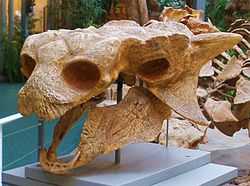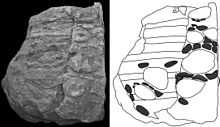Tarchia
| Tarchia Temporal range: Late Cretaceous | |
|---|---|
 | |
| Tarchia kielanae skull, formerly Minotaurasaurus | |
| Scientific classification | |
| Kingdom: | Animalia |
| Phylum: | Chordata |
| Clade: | Dinosauria |
| Order: | †Ornithischia |
| Family: | †Ankylosauridae |
| Subfamily: | †Ankylosaurinae |
| Genus: | †Tarchia Maryanska, 1977 |
| Species: | † T. kielanae |
| Binomial name | |
| Tarchia kielanae Maryańska, 1977 | |
| Synonyms | |
| |
Tarchia (meaning "brainy one") is a genus of herbivorous ankylosaurid dinosaur from the late Cretaceous of Mongolia.
Discovery and naming
In 1970, a Polish-Mongolian expedition discovered an ankylosaurian skull near Khulsan.
In 1977, Teresa Maryańska named and described the type species Tarchia kielanae. The generic name is derived from Mongolian tarkhi, "brain" and Latin ~ia, in reference to a brain size presumed larger than that of the related form Saichania. The specific name honours Professor Zofia Kielan-Jaworowska, the leader of the expedition.
The holotype, ZPal MgD-I/111, was discovered in the Upper Cretaceous (possibly Campanian-Maastrichtian) Barun Goyot Formation (previously known as the 'Lower Nemegt Beds') of the Nemegt Basin of Mongolia. It consists of a skull roof, braincase and rear skull elements.[1] Maryańska referred three additional specimens: ZPAL MgDI/43, a large postcranial skeleton containing three "free" tail vertebrae, twelve tail vertebrae of the "handle" of the tail club and a scute; ZPAL MgDI/49, a right humerus; and PIN 3142/251, a skeleton with skull, that as yet remains undescribed.
Tarchia is currently, with Saichania, among the geologically youngest known of all the Asian ankylosaurid dinosaurs.
In 1977, Tatyana Tumanova named a second species: Tarchia gigantea. This was a renaming of Dyoplosaurus giganteus Maleev 1956, which had been based on specimen PIN 551/29.[2] In 1987, Tumanova concluded that both species were identical. This would make Dyoplosaurus giganteus the senior synonym of Tarchia kielanae.[3] This was generally accepted and Tarchia gigantea became the usual species name, as a combinatio nova replacing Tarchia kielanae. However, recent study by Victoria Megan Arbour indicates that D. giganteus is indistinguishable from other ankylosaurs from the late Campanian-Maastrichtian of Mongolia, and hence a nomen dubium, reviving Tarchia kielanae.[4] A rump with tail and club, specimen ZPAL MgD I/113, once referred to Dyoplosaurus giganteus and subsequently to Tarchia gigantea, was by Arbour seen as different from the D. giganteus holotype.[5]
The study by Arbour also concluded that specimen PIN 3142/250, in 1977 referred to Tarchia by Tumanova, probably belonged to Saichania instead. This would radically change the common image of Tarchia as this exemplar had been by far the best preserved and most illustrations, museum mounts and indeed scientific research had been based on it. Arbour discovered that the holotype of Tarchia shared distinguishing traits with that of Minotaurasaurus Miles & Miles 2009, concluding that the latter is a junior synonym of Tarchia.[6]
Description

Size estimates of Tarchia have been largely based on Dyoplosaurus giganteus, the holotype of which is one of the largest ankylosaurian individuals known. This would make Tarchia the longest known Asian ankylosaur, with an estimated body length of 8 to 8.5 metres (26 to 28 ft) and weighing as much as 4.5 tonnes (5.0 short tons). Confusingly, the skull size often mentioned, with a length of 40 centimetres (16 in) and width of 45 centimetres (18 in), was again based on specimen PIN 3142/250, a much smaller individual. The holotypes of Tarchia kielanae and Minotaurasaurus also indicate a medium size. In 2010, Gregory S. Paul had estimated a body length of 4.5 metres and a weight of 1.5 tonnes.[7]
As an ankylosaurid, Tarchia would have had a broad, low-slung body, positioned on strong short legs. The body would have been protected by skin ossifications, named osteoderms. It probably had a bony tail club, for active defence against predators.
Tarchia had been distinguished from Saichania on the basis of its relatively larger basicranium, an unfused paroccipital process-quadrate contact and, based on PIN 3142/250, the fact that the premaxillary rostrum is wider than the maximum distance between the tooth rows in the maxillaries. Apart from the unique traits known exclusively from the holotype of Minotaurasaurus, Arbour in 2014 established two distinguishing traits. The back of the head is visible in top view. A deep groove runs along the front and outer side of the squamosal horn. At the front this groove runs around an accessory osteoderm placed on the rear supraorbital, forming a deep furrow.
Much information given about Tarchia in older work actually refers to PIN 3142/250. In 2001, it was stated that in Tarchia, wear facets indicative of tooth-to-tooth occlusion are present,[8] but in the holotype no teeth are preserved. The morphology of cranial sculpturing seen in Tarchia was indicated as an assortment of bulbous polygons, reminiscent of that of Saichania chulsanensis, the other ankylosaurid from the Barun Goyot Formation, but this can be explained by PIN 3142/250 belonging to that taxon.
Phylogeny
Vickaryous et alii in 2004 stated that Tarchia was basal to two distinct clades of Late Cretaceous ankylosaurids: one comprising North American taxa (Ankylosaurus, Euoplocephalus) and the other comprising Asian taxa (Pinacosaurus spp., Saichania, Tianzhenosaurus, Talarurus).[9] However, this was again based on PIN 3142/250, the characters of which usually defined the operational taxonomic unit named Tarchia in the various cladistic analyses. Remarkably, Tarchia and Saichania nevertheless in these analyses often occupied very different positions.

The following cladogram is based on the phylogenetic analysis of the Ankylosaurinae conducted by Arbour and Currie (2013), which shows Tarchia, now based on the holotype, and Saichania as sister species:[10]
| Ankylosaurinae |
| ||||||||||||||||||||||||||||||||||||||||||||||||||||||||||||||||||||||||
| |
Palaeobiology
The rocks in which Tarchia fossils were found likely represent eolian dunes and interdune environments, with small intermittent lakes and seasonal streams. Hence, we know that Tarchia was a desert animal. On the other hand, well-watered forest would have been present. Tarchia would have been preyed upon by Tarbosaurus.[7]
References
- Carpenter, K., Kirkland, J. I., Birge, D., and Bird, J. 2001. "Disarticulated skull of a new primitive anklyosaurid from the Lower Cretaceous of Utah", in Carpenter, K. (editor) 2001, The Armored Dinosaurs. Indiana University Press
Notes
- ↑ Maryańska, T. 1977. "Ankylosauridae (Dinosauria) from Mongolia". Palaeontologia Polonica 37: 85-151
- ↑ Tumanova, T. A. 1977. "New data on the ankylosaur Tarchia gigantea", Paleontological Journal 11: 480-486
- ↑ T.A. Tumanova, 1987, Pantsirnyye dinozavry Mongolii, Trudy Sovmestnaya Sovetsko-Mongol'skaya Paleontologicheskaya Ekspeditsiya 32, 80 pp
- ↑ Arbour, Victoria Megan, 2014. Systematics, evolution, and biogeography of the ankylosaurid dinosaurs. Ph.D thesis, University of Alberta. https://era.library.ualberta.ca/public/.../Arbour_Victoria_Spring2014.pdf
- ↑ Victoria M. Arbour, Nicolai L. Lech-Hernes, Tom E. Guldberg, Jørn H. Hurum, and Philip J. Currie, 2013, "An ankylosaurid dinosaur from Mongolia with in situ armour and keratinous scale impressions", Acta Palaeontologica Polonica 58(1): 55-64
- ↑ Victoria M. Arbour, Philip J. Currie and Demchig Badamgarav, 2014, "The ankylosaurid dinosaurs of the Upper Cretaceous Baruungoyot and Nemegt formations of Mongolia", Zoological Journal of the Linnean Society 172(3): 631–652
- ↑ 7.0 7.1 Paul, G.S., 2010, The Princeton Field Guide to Dinosaurs, Princeton University Press p. 231
- ↑ Barrett, P.M. 2001. "Tooth wear and possible jaw action in Scelidosaurus harrisonii and a review of feeding mechanisms in other thyreophoran dinoaurs", in Carpenter, K. (ed.) The Armored Dinosaurs. Indiana University Press, Bloomington. pp. 25–52
- ↑ Vickaryous, Maryańska, and Weishampel, 2004, Chapter Seventeen: "Ankylosauria", in: The Dinosauria (2nd edition), Weishampel, D. B., Dodson, P., and Osmólska, H., editors. University of California Press.
- ↑ Arbour V.M. and Currie P.J., 2013, "Euoplocephalus tutus and the Diversity of Ankylosaurid Dinosaurs in the Late Cretaceous of Alberta, Canada, and Montana, USA", PLoS ONE 8(5): e62421. doi:10.1371/journal.pone.0062421